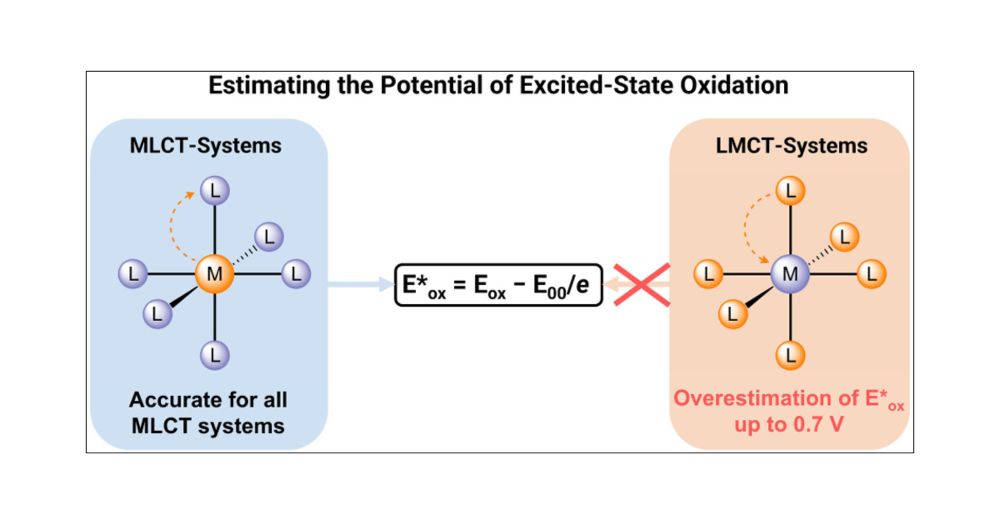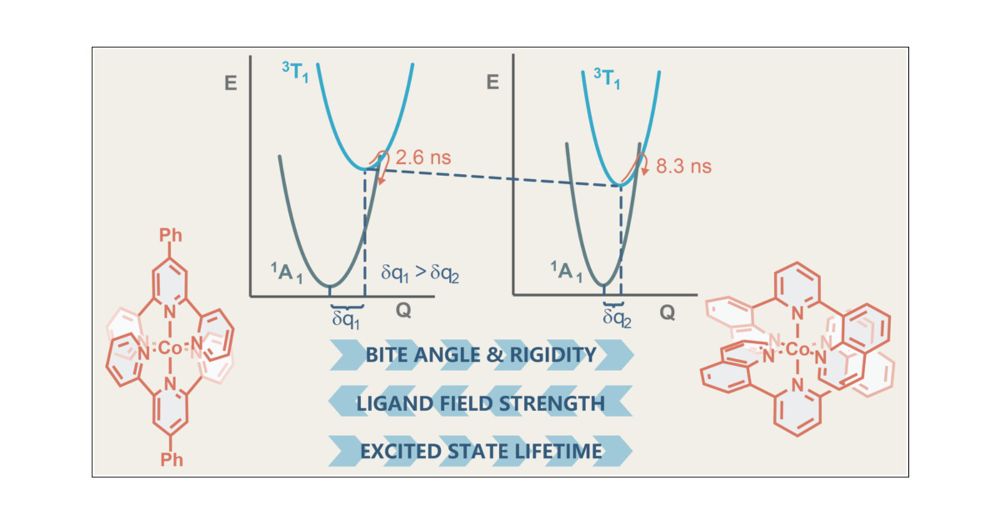Björn Pfund
@bjoernpfund.bsky.social
Postdoc in the McCusker group | PhD at University of Basel
Photochemistry🔦 | Lasers⚡️ | Spectroscopy 📸
Photochemistry🔦 | Lasers⚡️ | Spectroscopy 📸
Reposted by Björn Pfund
A molecular dyad of an iron complex covalently bound to an annihilator exhibits three photoactive excited states — singlet, doublet, and triplet — enabling homomolecular upconversion
Florian Doettinger, Jonathan Sagaya, Giacomo Morselli in @jacs.acspublications.org
pubs.acs.org/doi/10.1021/...
Florian Doettinger, Jonathan Sagaya, Giacomo Morselli in @jacs.acspublications.org
pubs.acs.org/doi/10.1021/...

Homomolecular Photon Upconversion in a Perylene-Decorated Iron(III) Complex
Classical upconversion employs sensitizers and annihilators as two distinct molecular species and is, therefore, classified as heteromolecular. Homomolecular upconversion, the unification of both role...
pubs.acs.org
November 9, 2025 at 2:40 PM
A molecular dyad of an iron complex covalently bound to an annihilator exhibits three photoactive excited states — singlet, doublet, and triplet — enabling homomolecular upconversion
Florian Doettinger, Jonathan Sagaya, Giacomo Morselli in @jacs.acspublications.org
pubs.acs.org/doi/10.1021/...
Florian Doettinger, Jonathan Sagaya, Giacomo Morselli in @jacs.acspublications.org
pubs.acs.org/doi/10.1021/...
Reposted by Björn Pfund
Our study about dissipative ILET in {Ru(tpy)(bpy)} chromophores upon light absorption is out in Inorg. Chem. @acs.org ! it outcompetes diffusional reactivity = significant losses. Collab @solarfau.bsky.social @fau.de 🤝 Pedro Abate, Daiana Cabrosi and Luis Baraldo at UBA
pubs.acs.org/doi/full/10....
pubs.acs.org/doi/full/10....

Ultrafast Dissipation via Interligand Electron Transfer in {Ru(tpy)(bpy)} Chromophores
With the aim of studying interligand electron transfer (ILET) with different driving forces, [Ru(tpy)(R-bpy)(CN)]+ complexes with R-bpy = 4,4′-dimethylamino-2,2′-bipyridine (dMAb), 4,4′-dimethoxy-2,2′...
pubs.acs.org
October 23, 2025 at 6:35 PM
Our study about dissipative ILET in {Ru(tpy)(bpy)} chromophores upon light absorption is out in Inorg. Chem. @acs.org ! it outcompetes diffusional reactivity = significant losses. Collab @solarfau.bsky.social @fau.de 🤝 Pedro Abate, Daiana Cabrosi and Luis Baraldo at UBA
pubs.acs.org/doi/full/10....
pubs.acs.org/doi/full/10....
Reposted by Björn Pfund
Super excited to see our work monitoring dynamics of the charge separated pair in a photocycle driven by a 2LMCT exited state now out in @chemicalscience.rsc.org ! ⚡️
Thanks for the great team efforts🌟
pubs.rsc.org/en/content/a...
Thanks for the great team efforts🌟
pubs.rsc.org/en/content/a...

Captivating bimolecular photoredox dynamics of a ligand-to-metal charge transfer complex
Transition metal complexes featuring ligand-to-metal charge transfer (LMCT) excited states have been identified as promising candidates for driving electron transfer processes. To obtain an efficient ...
pubs.rsc.org
October 20, 2025 at 2:30 PM
Super excited to see our work monitoring dynamics of the charge separated pair in a photocycle driven by a 2LMCT exited state now out in @chemicalscience.rsc.org ! ⚡️
Thanks for the great team efforts🌟
pubs.rsc.org/en/content/a...
Thanks for the great team efforts🌟
pubs.rsc.org/en/content/a...
Exploring metal-centered photoredox reactivity? 🚀Don’t forget to look at the spin-state landscape and the role of reorganisation energy, they can make a difference 😉
Huge thanks to Bekah for leading the experiments and shaping the story🥳 a true collaborative effort!😃
pubs.acs.org/doi/10.1021/...
Huge thanks to Bekah for leading the experiments and shaping the story🥳 a true collaborative effort!😃
pubs.acs.org/doi/10.1021/...

Spin-State and Reorganization Energy Considerations for Metal-Centered Photoredox Catalysis
Transition-metal complexes featuring metal-centered excited states have recently emerged as mechanistically distinct platforms for selective photochemistry, including photoredox catalysis. Among these...
pubs.acs.org
October 16, 2025 at 3:58 PM
Exploring metal-centered photoredox reactivity? 🚀Don’t forget to look at the spin-state landscape and the role of reorganisation energy, they can make a difference 😉
Huge thanks to Bekah for leading the experiments and shaping the story🥳 a true collaborative effort!😃
pubs.acs.org/doi/10.1021/...
Huge thanks to Bekah for leading the experiments and shaping the story🥳 a true collaborative effort!😃
pubs.acs.org/doi/10.1021/...
Reposted by Björn Pfund
Molecular Design Principles for Achieving High-Efficiency Light-Induced Charge Separation at the Nanometer Scale
Mathis Brändlin and Felix Himmelreich in jacsau.bsky.social
pubs.acs.org/doi/full/10....
Mathis Brändlin and Felix Himmelreich in jacsau.bsky.social
pubs.acs.org/doi/full/10....

Molecular Design Principles for Achieving High-Efficiency Light-Induced Charge Separation at the Nanometer Scale
The light-induced separation of charges, fundamental to natural photosynthesis, is key to converting solar energy into chemical energy in artificial systems. One challenge is that charges tend to spon...
pubs.acs.org
October 15, 2025 at 7:16 AM
Molecular Design Principles for Achieving High-Efficiency Light-Induced Charge Separation at the Nanometer Scale
Mathis Brändlin and Felix Himmelreich in jacsau.bsky.social
pubs.acs.org/doi/full/10....
Mathis Brändlin and Felix Himmelreich in jacsau.bsky.social
pubs.acs.org/doi/full/10....
Reposted by Björn Pfund
Artificial photosynthesis could be the key to environmentally friendly fuels. A research team led by @wengeroliver.bsky.social has developed a special molecule that can store four charges simultaneously under light irradiation. Wenger calls this molecule "an important piece of the puzzle."

Chemists develop molecule for important step toward artificial photosynthesis
A research team from the University of Basel has developed a new molecule modeled on plant photosynthesis: under the influence of light, it stores two positive and two negative charges at the same tim...
www.unibas.ch
August 25, 2025 at 9:39 AM
Artificial photosynthesis could be the key to environmentally friendly fuels. A research team led by @wengeroliver.bsky.social has developed a special molecule that can store four charges simultaneously under light irradiation. Wenger calls this molecule "an important piece of the puzzle."
Reposted by Björn Pfund
Rethinking Iron Photoredox Catalysis
For Fe(III) complexes, excited-state redox potentials don’t follow the usual rules - standard estimation methods fall short
Joël Wellauer with Paul Francis & colleagues at Deakin University in @jacs.acspublications.org
pubs.acs.org/doi/10.1021/...
For Fe(III) complexes, excited-state redox potentials don’t follow the usual rules - standard estimation methods fall short
Joël Wellauer with Paul Francis & colleagues at Deakin University in @jacs.acspublications.org
pubs.acs.org/doi/10.1021/...

Rethinking the Excited-State Redox Properties of Iron(III) Complexes for LMCT Photoredox Catalysis
The reduction potentials of electronically excited states are crucial input values for photoredox reaction design. Since they are not directly measurable, they are typically estimated from the corresp...
pubs.acs.org
August 4, 2025 at 1:48 PM
Rethinking Iron Photoredox Catalysis
For Fe(III) complexes, excited-state redox potentials don’t follow the usual rules - standard estimation methods fall short
Joël Wellauer with Paul Francis & colleagues at Deakin University in @jacs.acspublications.org
pubs.acs.org/doi/10.1021/...
For Fe(III) complexes, excited-state redox potentials don’t follow the usual rules - standard estimation methods fall short
Joël Wellauer with Paul Francis & colleagues at Deakin University in @jacs.acspublications.org
pubs.acs.org/doi/10.1021/...
Reposted by Björn Pfund
Cr(III) complexes with enhanced metal–ligand covalency enable tunable NIR luminescence and red-light photoreduction.
@giacomo-morselli94.bsky.social & team find signs of doublet–doublet annihilation, or excited-state disproportionation.
In @jacs.acspublications.org
pubs.acs.org/doi/10.1021/...
@giacomo-morselli94.bsky.social & team find signs of doublet–doublet annihilation, or excited-state disproportionation.
In @jacs.acspublications.org
pubs.acs.org/doi/10.1021/...

Pushing the Thermodynamic and Kinetic Limits of Near-Infrared Emissive CrIII Complexes in Photocatalysis
Photoactive CrIII complexes are typically based on polypyridine coordination environments, exhibit red luminescence, and are good photo-oxidants but have modest photoreducing properties. We report new...
pubs.acs.org
July 29, 2025 at 7:20 AM
Cr(III) complexes with enhanced metal–ligand covalency enable tunable NIR luminescence and red-light photoreduction.
@giacomo-morselli94.bsky.social & team find signs of doublet–doublet annihilation, or excited-state disproportionation.
In @jacs.acspublications.org
pubs.acs.org/doi/10.1021/...
@giacomo-morselli94.bsky.social & team find signs of doublet–doublet annihilation, or excited-state disproportionation.
In @jacs.acspublications.org
pubs.acs.org/doi/10.1021/...
Reposted by Björn Pfund
Bite angle optimization weakens ligand fields in cobalt(III) complexes, yet lifetimes can increase due to rigidification
pi-donor (instead of pi-acceptor) ligand properties are key
now in @jacs.acspublications.org
pubs.acs.org/doi/10.1021/...
pi-donor (instead of pi-acceptor) ligand properties are key
now in @jacs.acspublications.org
pubs.acs.org/doi/10.1021/...

Structural Control of Metal-Centered Excited States in Cobalt(III) Complexes via Bite Angle and π–π Interactions
CoIII complexes have recently become an important focus in photophysics and photoredox catalysis due to metal-centered excited states with strong oxidizing properties. Optimizing chelate ligand bite a...
pubs.acs.org
July 31, 2025 at 7:35 AM
Bite angle optimization weakens ligand fields in cobalt(III) complexes, yet lifetimes can increase due to rigidification
pi-donor (instead of pi-acceptor) ligand properties are key
now in @jacs.acspublications.org
pubs.acs.org/doi/10.1021/...
pi-donor (instead of pi-acceptor) ligand properties are key
now in @jacs.acspublications.org
pubs.acs.org/doi/10.1021/...
Reposted by Björn Pfund
We show how photoredox catalysis can bypass Kasha’s rule, enabling reactions from higher excited states.
This work, led by the exceptional @bjoernpfund.bsky.social, offers new insights into photochemical reactivity.
Published in JACS @jacs.acspublications.org
bit.ly/3IysmjX
This work, led by the exceptional @bjoernpfund.bsky.social, offers new insights into photochemical reactivity.
Published in JACS @jacs.acspublications.org
bit.ly/3IysmjX

Breaking Kasha’s Rule to Enable Higher Reactivity in Photoredox Catalysis
Nearly all photochemical transformations known to date follow Kasha’s rule, implying that reactions occur only from the lowest electronically excited state of a given spin multiplicity due to the fast...
bit.ly
July 18, 2025 at 7:00 AM
We show how photoredox catalysis can bypass Kasha’s rule, enabling reactions from higher excited states.
This work, led by the exceptional @bjoernpfund.bsky.social, offers new insights into photochemical reactivity.
Published in JACS @jacs.acspublications.org
bit.ly/3IysmjX
This work, led by the exceptional @bjoernpfund.bsky.social, offers new insights into photochemical reactivity.
Published in JACS @jacs.acspublications.org
bit.ly/3IysmjX
Thrilled to share our new JACS paper on anti-Kasha photoreactivity!
We show that higher-lying excited states can drive electron transfer — opening new doors for photoredox catalysis.
Huge thanks to @wengeroliver.bsky.social for the incredible mentorship!
pubs.acs.org/doi/10.1021/...
We show that higher-lying excited states can drive electron transfer — opening new doors for photoredox catalysis.
Huge thanks to @wengeroliver.bsky.social for the incredible mentorship!
pubs.acs.org/doi/10.1021/...
pubs.acs.org
July 18, 2025 at 10:03 AM
Thrilled to share our new JACS paper on anti-Kasha photoreactivity!
We show that higher-lying excited states can drive electron transfer — opening new doors for photoredox catalysis.
Huge thanks to @wengeroliver.bsky.social for the incredible mentorship!
pubs.acs.org/doi/10.1021/...
We show that higher-lying excited states can drive electron transfer — opening new doors for photoredox catalysis.
Huge thanks to @wengeroliver.bsky.social for the incredible mentorship!
pubs.acs.org/doi/10.1021/...

